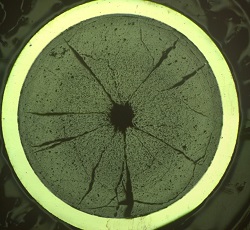Getting nearer to closing the nuclear fuel cycle, for reduced radiotoxicity
Minor-Actinide (MA) are long-term radioactive elements such as Americium (Am), Neptunium(Np) or Curium (Cm) that are present in spent nuclear fuels. If these MA radionuclides are separated during the partitioning step of the HLLW reprocessing process and then transmuted into radioelements with shorter half-lives in a nuclear power plant, the remaining waste contains greatly reduced long-term radiotoxicity. To achieve this, the EU-funded PELGRIMM project investigated dedicated nuclear fuels, within two approaches: MA homogeneous recycle, where a few percent of MAs are diluted in Uranium Plutonium Oxide (U,Pu)O2 driver fuels and MA heterogeneous recycle where MAs are concentrated in UO2 fuels, located in the radial core blanket. PELGRIMM first had to overcome a number of challenges, such as the preparation and implementation of the new irradiation test MARINE on (U,Am)O2 fuels in the High Flux Reactor in Petten, The Netherlands. Exploring fuels for the homogeneous and heterogeneous recycles Related to MA homogeneous recycle, PELGRIMM investigated the (U,Pu,Am)O2 performances under irradiation through an experimental program on irradiated fuels, in order to enrich and extend the available database and through model developments, to upgrade codes. For the heterogeneous recycle, unique results on (Am,U)O2 irradiated fuels were gained and the new irradiation MARINE was successfully completed; new models to describe the fuel irradiation behaviour were also developed. As project coordinator, Doctor Fabienne Delage acknowledges, ‘Both kinds of MA-bearing fuel investigations started quite recently. Experimental knowledge remains limited to laboratory-scale fabrication process, to small amount of out-of-pile test results, and to scarce irradiation experiments.’ Another aspect to the project was the study of fuels shaped as small spherical beads (spherepac), as an alternative to standard pellets. The spherepac technology is attractive for MA-bearing fuels as it simplifies the fabrication process, thanks to the elimination of some process steps as milling, pressing and grinding that involve fuel powders (and dust). Moreover, the compactness of the fabrication process would be increased. It is also hypothesized, but as yet untested, that the spheres could offer improved fuel performance under irradiation, due to a better accommodation of solid swelling and better management of the helium generated during irradiation. According to Dr Delage, ‘A significant contribution that PELGRIMM has made to both MA recycling scenarios is to build on the lengthy, multi-stage investigations into fuel performance potential and limitation assessments. These are usually longer than projects’ duration of typically three to four years.’ Building on prior success Indeed, the PELGRIMM project capitalised on the efforts of previous EU-funded projects, such as FAIRFUELS and ACSEPT, towards efficiently closing the nuclear fuel cycle, ultimately towards the reduction of the volume and radioactive content of long-lived nuclear waste, to be disposed in geological repositories. In terms of next steps, Dr Delage highlights a few necessary further Research and Development efforts. As she points out, ‘There is a need to increase the set of irradiation results by firstly, performing and completing Post-Irradiation Examinations on irradiated fuels already available. Secondly, by testing fuels in reactor operating and off-normal conditions.’ Additional focus areas Dr Delage cites, include the extension of the fuel properties database, continued establishment of predictive fuel performance codes, progress in fabrication techniques from lab- to pilot-scale, and the increased considerations of reactor core physics, design and safety performance, as well as second waste streams management.



